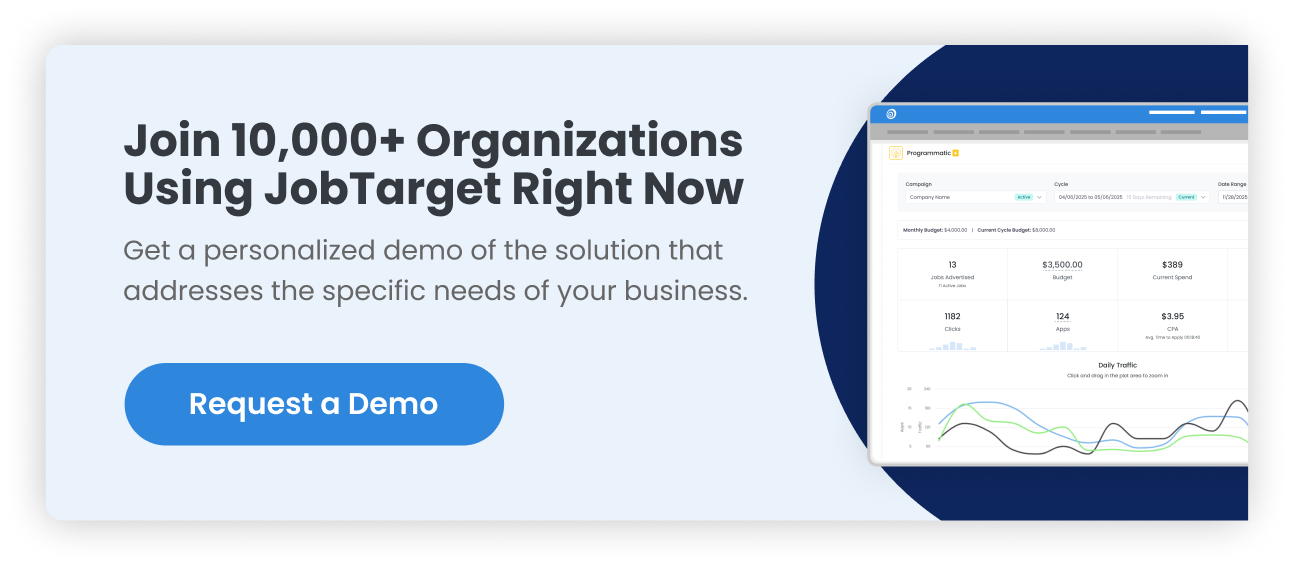Most recruitment teams understand the obvious costs of hiring: job board subscriptions, recruiter salaries, advertising spend. Few calculate the hidden tax of managing fragmented systems.
Consider the typical workflow: A recruiter needs to fill five open positions. Each role requires posting to 8-10 job boards to reach qualified candidates. That's 40-50 individual postings, each requiring separate logins, unique formatting requirements, payment processing, and performance tracking across disconnected dashboards.
Lauren Plante, Senior Director of Programmatic at JobTarget, quantifies this inefficiency clearly: "Instead of going to 10 different job boards or sites top advertise your positions, you're able to, in one click, get your jobs out to the necessary sites. It changes the game immediately."
This isn't hyperbole. Organizations waste upwards of 15-20 hours per week on job distribution logistics rather than strategic recruiting activities.
Beyond Distribution: Intelligent Budget Allocation
Job board reach matters, but intelligent spending matters more.
Traditional multi-board strategies operate on guesswork. Recruiters purchase postings across various sites hoping one performs well. When a role fills, attributing success to the right channel becomes nearly impossible. Budget decisions for the next hire cycle rely on incomplete data or gut instinct.
JobTarget's Programmatic solution flips this model. The platform continuously analyzes performance across 100+ sites, automatically allocating budget to channels delivering the highest visibility and qualified traffic.
"You can trust that you're not just throwing your dollars out there to sites hoping it will work," Plante explains. "We're able to use our data and logic to see how your posts are responding and ensure that your dollars are going to the sites that are going to give you the most visibility and traffic."
This data-driven approach delivers measurable results. Organizations using JobTarget reduce cost per hire by 30% while engaging qualified candidates 3x faster [verified JobTarget statistics].
Integration: The Overlooked Differentiator
Most programmatic job advertising vendors focus marketing on reach and algorithms. JobTarget's competitive advantage lies elsewhere: 80+ prebuilt ATS integrations that eliminate implementation friction.
"JobTarget isn't just a programmatic service," Plante notes. "We're able to partner with ATS systems to be more integrated into a customer's current environment so they don't have to change the way they work."
This matters more than most organizations realize during vendor evaluation. A powerful programmatic engine means nothing if adoption requires workflow overhauls, IT involvement, or weeks of implementation. JobTarget's platform connects directly to existing HR systems, removing friction and delivering immediate time savings.
For small HR teams managing multiple responsibilities, this integration advantage becomes critical. No learning curve. No workflow disruption. Immediate access to strategic job distribution through existing systems.
Transparency as Strategic Advantage
Programmatic advertising suffers from a perception problem: complexity breeds suspicion. Organizations worry they're paying for performance they can't verify or understand.
JobTarget addresses this by providing clear performance dashboards showing what matters most: application volume, candidate quality, and cost metrics. You see exactly what your recruitment investment generates without needing to decode complex algorithms.
"We're transparent about what our customer's data means," Plante explains. "We provide education pieces on how the systems work. We're making our products as intuitive as possible so customers can truly educate themselves and feel in control of their data."
This approach extends beyond dashboards. JobTarget built a comprehensive Help Center with video tutorials and detailed articles explaining exactly how Programmatic works. Customers gain education, not just access.
The result: trust. Organizations understand their cost per application, applicant volume, and performance trends over time. This transparency transforms JobTarget from vendor to strategic partner.
Evolution: Growing With Market Demands
Technology vendors often launch products and declare victory. JobTarget's approach differs significantly.
Since Programmatic's launch, the product team continuously expanded capabilities based on customer feedback:
Network Expansion: The platform now reaches 100+ sites and publishers, spanning major job boards to specialized niche sites serving specific industries and roles.
Flexible Purchasing: Organizations access multiple product tiers (per-job products, credit pack bundles, prepaid postings) matching various budget models and hiring patterns.
Enhanced Functionality: Easy Apply integration increases application volume by 4x. Updated dashboards provide more personalized reporting. Job management tools allow easy addition and removal of postings.
"We have a team of product specialists that look for themes or continued pain points for customers, implementing feedback consistently," Plante notes.
This commitment to evolution matters during economic uncertainty. Hiring slowdowns force budget scrutiny. Programmatic's data-driven approach proves value: organizations see exactly where dollars go and what results they generate. Historical performance data enables confident budget allocation even when overall spend decreases.
The One-Stop-Shop Reality
When asked to summarize Programmatic in one phrase, Plante chose "one-stop-shop." This positioning extends beyond marketing copy.
JobTarget's platform doesn't end with job distribution. Programmatic integrates with complementary tools creating a comprehensive recruitment ecosystem:
- Sourcer: Access to a 120M+ passive candidate database for proactive recruiting
- Intelligent Reporting and Compensation Analyzer: Market and labor data informing competitive compensation strategies
- Video Interviewer: Streamlined screening processes
Organizations manage the entire candidate journey through one unified platform rather than cobbling together point solutions from multiple vendors.
"We have more resources available to our customers," Plante explains. "All of our products and services work together to build more tools into the toolbox."
Perhaps most valuable: centralized support. Instead of managing relationships with 15+ vendors, organizations work with one dedicated team that understands their complete recruitment strategy.
What This Means for Your Recruitment Strategy
The recruitment technology landscape grows more complex daily. New job boards launch. Candidate preferences shift. Economic conditions fluctuate. Maintaining competitive hiring practices while managing this complexity stretches HR teams beyond capacity.
Strategic job distribution through programmatic advertising eliminates this burden. Organizations gain expert partners who monitor market changes, optimize budget allocation, and provide transparent performance data—all through systems already in place.
JobTarget serves 10,000+ customers who've delivered 200M+ job postings and received 1B+ applications through the platform [verified JobTarget statistics]. This scale creates network effects: performance data across thousands of organizations informs smarter budget allocation for everyone.
The question isn't whether your organization should adopt programmatic job advertising. The market has already decided that strategic, data-driven distribution beats manual, fragmented posting. The question is which partner to trust with this critical function.
As Plante concludes: "Trust is our biggest asset. And our people are just the cherry on top."







